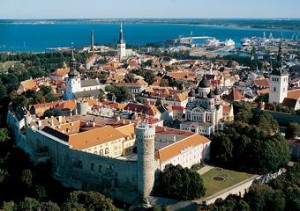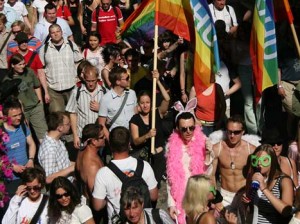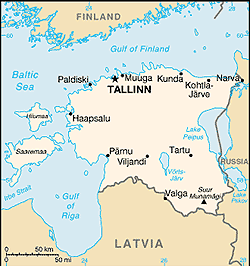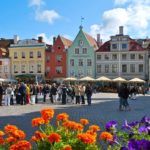Introduction
Establishing a “Gay Life in Estonia” is becoming an achievable reality through education, tolerance and government support. Estonia is a small country with hope in the air and in the streets that reaching a level of gay tolerance and presence will not take a decade more and not through bloodshed and social upheaval. First, both male and female same-sex sexual activity are legal in Estonia, having been decriminalized in 1992. Second, in 2006 only 21% of the population were willing to accept gay marriage; by 2009 the approval rate was up to 32%. Third, Gay Pride Parades have been organized since 2004 with much less opposition than in the other Baltic countries, Latvia and Lithuania. In 2011 the Pride event was attended by Estonian government officials as well as the British ambassador and EU representatives.
Compiled by Richard Ammon
GlobalGayz.com
March 2012
Cause For Celebration
In November 2011, in the capital city of Tallnin and other major cities, the law school at Tallinn University of Technology organized an outdoor media campaign called “Difference Enriches,” intended to educate against homophobia. To emphasize the authority of the campaign it was financed by the Estonian Ministry of Social Affairs as well as by the European Union’s ‘Progress Program’.
Also, in September 2011 the first LGBT Center opened with much fanfare and publicity. It is open for information regarding local gay life, to sponsor events and as a safe meeting place with a lounge, a computer with WiFi internet access, a library and a kitchen. It is not sure if the Center will develop a program of political activism and lobbying for legal protections and equal rights. According to the Gay Guide to Tallnin says that several gay activist groups have been formed in Tallinn since 1990 but did not name them.
There is an official guide for LGBT Tallnin with a website. Here can be found a Gay Map online for locals and visitors. A hard copy is also available. The age of consent is 14 years and was equalized for both homosexual and heterosexual sex in 2001.
From 6 June to 12 June 2011, Estonia hosted Baltic Pride, a festival to promote greater support and awareness of LGBT citizens. Key speakers at the event included Riho Rahuoja, the Deputy Secretary General for Social Policy at the Ministry of Social Affairs; Christian Veske, the Chief Specialist in the Ministry’s Gender Equality Department; Kari Käsper, Project Manager of the “Diversity Enriches” campaign from the Estonian Human Rights Centre; Hanna Kannelmäe from the Estonian Gay Youth NGO and the British Ambassador to Estonia Peter Carter. Previously, in March 2011, British photographer Clare B. Dimyon exhibited her photo exhibitit “Proud of our Identity” at Tallinn’s Solaris Centre. The exhibit comprised photographs of and by lesbian, gay, bisexual and transgender people taken at various Pride events throughout Europe, including photographs of gay Estonians.
Celebration But With Caution
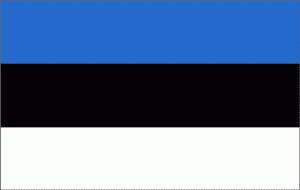
This is not to say Estonia is an easy sell for LGBT rights and lifestyle. It is hard to precisely define what makes Estonia different from neighboring homophobic countries, including Poland. The usual villains are religion, politics, right-wing traditionalists and skinheads. On the Tallnin Guide website these comments appear:
“Despite being viewed as the most liberal and tolerant of the Baltic capitals, Tallinn, like Riga in Latvia and Vilnius in Lithuania, still has a long way to go to catch up with neighboring Scandinavian countries and Western Europe when it comes to homosexuality. While homophobia is not as entrenched in the media in Estonia as it is in ‘uber-Catholic’ Lithuania and Poland, it is still very much entrenched in the public psyche. As with most Estonian problems, communism can be conveniently blamed for this one as well. After all, homosexuality apparently didn’t exist under Stalin… so they believed.”
Some researchers have observed that after independence from the Soviets, gays in Estonia still had to counter cultural factors like individualism, a strong preference for privacy, and distrust of the government which impeded political action and community organization.
In June 2006, the Dutch Ambassador to Estonia Hans Glaubitz asked to be transferred to the Dutch consulate in Montreal, Canada after counting homophobic and racial verbal abuse aimed against his partner, an Afro-Cuban dancer named Raúl García Lao, by racists and bigots in Tallinn. The incident caused international news. In response, a statement by the Estonian authorities “regretted the incidents very much”. http://en.wikipedia.org/wiki/LGBT_rights_in_Estonia
In that same year, however, violence disrupted the 2006 Tallinn Pride march when skinheads and low-class gangs injured 15 people with sticks and stones.
Tallinn Pride coordinator Lisette Kampus said that Baltic people are generally very tolerant of sexual minorities: “It’s not fair to say they aren’t gay-friendly, they are. The objectors are a small minority who are really radically against gay issues, and they have a very loud voice. What differs us from Western Europe is that, there, society has made it clear that those types of attitudes are not okay. In the Baltics, nobody is reacting against these negative opinions.”
She went on to say, “though gay tourists coming to Tallinn may feel a marked difference in Estonia in terms of the country’s openness toward gays, travelers generally have little to fear in terms of gay-bashing. Nonetheless, discretion is a good defense and one still employed by most of Tallinn’s gay-oriented nightclubs, the number of which continues to grow, and there is no doubt that Tallinn outshines both Riga and Vilnius (perhaps both combined) when it comes to gay nightlife.”
To reconfirm their bigotry, in July 2011, the Estonian Council of Churches (Evangelical Lutheran, Roman Catholic, Orthodox churches and a number of Free Churches) sent an open message to the Ministry of Justice in response to the Chancellor’s statement about registering unmarried partnerships: “The Council of Churches does not tolerate homosexuality,” claiming that traditional hetero marriage is a guarantee of stability for Estonian people and Estonian State. Nothing new here other than the obvious threat the backward-looking Christians are feeling in the face of modern social ideas.
Religion in Estonia
http://www.kinseyinstitute.org/ccies/ee.php
The dominant religion in Estonia is Evangelical Lutheranism, while the Estonian Apostolic-Orthodox Church, the Russian Orthodox Church and the Estonian Evangelical Baptist church all have a presence. Both Russian (15%) and Estonian (83%) languages are spoken.
Most of the religious adherents among the country’s Russian-speaking population are Orthodox, while the Estonian majority is predominantly Lutheran. There is a deep-seated tradition of tolerance of other denominations and religions. Although the majority of citizens are nominally Lutheran, ecumenical services during national days, Christian holidays, or at public events are common. Tension between the ethnic Estonian and ethnic Russian populations generally do not extend to religious matters.
Tolerance and Sex in Estonia
Perhaps because sex education is included in the schools health education curricula (as well as other social and personal factors) sex research in Estonia reveals moderate levels of tolerance for variations that deviate from the ‘strict norm’ of heterosexual monogamous marital intimacy. Hetero-infidelity is not uncommon among married couples, especially among men.
The following information comes from the International Encyclopedia of Sexuality (2004) regarding homosexuality in Estonia, written by Elina Haavio-Mannila, PhD (Department of Sociology, P.O. Box 18 (Unioninkatu 35), FIN-00014 University of Helsinki, Finland; elina.haavio-mannila @ helsinki.fi).
“Regarding same-sex activity, male homosexuality was not punishable in the independent Estonian Republic before World War II. During the Soviet occupation, male homosexual behavior—specifically anal intercourse between men—was forbidden everywhere in the Soviet Union. However, the situation seemed to be more liberal in occupied Estonia than in most other parts of the former Soviet Union. Gay men who had no public sex or political problems, were usually not persecuted. Up to the mid-1980s, there was an unofficial gay bar in Tallinn and there was at least one cruising area in both Tallinn and Tartu.
“A decisive year for Estonian homosexuals was 1990, when the International Scientific Conference on Sexual Minorities and Society in Twentieth Century Europe took place in Tallinn, the first of this kind in Eastern Europe. Also, during 1990, the first advertisements for gay and lesbian acquaintances were published in independent newspapers. The first gay/lesbian organization in Estonia was the Estonian Lesbian Union, founded in 1990, followed two years later by the Estonian Gay League.”
Today Estonia expresses an ambivalence toward homosexuality. “In Estonia in 2000, 50% of surveyed men and 63% of women agreed with the statement “Homosexuality among adults is a private affair of the people concerned with which officials the law should in no way interfere; 29% of men and 25% of women found it hard to say what their position was.”
Regarding the more recent and controversial issue of gay marriage, younger people are more liberal than older people. In 2009 the approval rate was up to a full third of polled citizens, in favor of such unions.
“One should notice that the majority of the population has a favorable attitude toward homosexual behavior between adults; it is seen as a private affair with which officials and the state should not interfere.
“In the 2000 Estonian sex survey, people gave their opinions on the following statement: “I have nothing against people earning money by selling sexual services (prostitution).” Fifty-five percent of men and 30% of women agreed entirely or almost completely with this statement. There was no difference between the national groups. Young people accepted it more often than middle-aged and older people. Type of relationship and education were not significantly connected with prostitution attitudes. Compared to the neighboring countries, Estonia was the most permissive to prostitution.” (http://www.kinseyinstitute.org/ccies/ee.php#homoerot)
Gay Marriage in Estonia
Estonia and Homosexuality: Between (little) Tolerance and Inclusion
From: Lithuania Tribune
http://www.lithuaniatribune.com/2010/07/06/estonia-and-homosexuality-between-little-tolerance-and-inclusion/
June 7, 2010
“The public debate about homosexual-marriage was re-ignited again in Europe a few days ago when Iceland’s openly lesbian Prime Minister Johanna Sigurdardottir became the first head of any government to enter into a gay marriage.
“Last week, Estonia´s Prime Minister referred to the gay marriage issue in his own country when he was asked about his opinion. Ansip stated, “I think that marriage between man and woman is a sacred relationship, but I totally accept the fact that same-sex cohabitation could have the same social guarantees, such as the married couples.
“After this PM statement, Estonian Free Press contacted the Estonian Gay Youth association for their view on this matter. The law in Estonia does not forbid same sex relations, however in the view of Madle Saluveer, member of the Estonian Gay Youth association, it does not give any guarantees as well. “In the Equal Treatment Law, it is only forbidden to discriminate somebody on the ground of sexual orientation at the workplace, whereas it is not mentioned in the areas of education or social services.
“In Europe there are several countries like Belgium, Netherlands, Portugal or Spain that recognize same sex marriage but not Estonia. And it seems it is going to be like this for more time as the new Family Law, a provision that took effect from the first of July, states in its first article clearly that “Marriage is the union between a man and a woman”.
“Prime Minister Andrus Ansip also referred to a possible future change in the regulations ruling in the Baltic States saying: “I do not believe that Estonia, Latvia and Lithuania would soon accept same-sex marriage in the eyes of the law, but it does not mean that same-sex couples living together would not be tolerated. This is certainly not so; Estonia is a tolerant country
“But for Mrs Saluveer, this statement could be understood in two ways “As what comes from the Prime Minister’s statement, I would like to stress that there’s a huge difference on being tolerant and being accepting and inclusive. Estonia being a tolerant country to me reads exactly: “we do not ban your homosexual relations, we let you be (especially if you’re very quiet and don’t request more than you’re given)“, whereas giving LGBT people the guarantees of having a legally recognized family would make Estonia an inclusive and accepting, open-minded European country”
According to the international league of Lesbians, Gays, Bisexuals, Transsexuals and Intersex associations, there is a discrimination based on sexual orientation, an affirmation that the Estonian Gay Youth association supports with some examples: “We do have to agree that hateful acts and discrimination is present in Estonia towards LGBT-people”.
One of the most recent cases of discrimination for the homosexual community happened in Viimsi County, where the support for transportation and school dinners was denied to a lesbian couple. The support was legally entitled to families raising 3 kids or more. “Although it was guaranteed that being married is not a requirement to receive the support, they soon got turned down, with the authorities saying that because in Estonia a marriage is only legally possible between a man and a woman; their family cannot be considered as one. The authorities in the county even changed the regulation after the incident, trying to ensure that it would only be possible for heterosexual couples to apply for the support” said Madle Sauveer.
The case finally was delivered to a court of justice where the couple prevailed in the case. According to Mrs Sauveer, in the roots of discrimination against this community is tradition.
Links
The Gay Guide website lists numerous venues popular with gay locals and visitors:
http://www.tallinn-life.com/tallinn/gay-tallinn
Gay & Lesbian Info Office – Tangible info from real people
Tartu mnt 29
tel: +372 5811 6969
gay@gay.ee
www.gay.ee
Pink Baltics – The first gay travel company in the Baltics (in English)
www.pinkbaltics.com
Gaycity.ee – Estonian personals, chat, tourist info, forum and more
www.gaycity.ee
Tallinn Pride – Info on annual Tallinn Pride festival (in English)
www.pride.ee
Tallinn Goes Rainbows – Info on Moonbow Pride and Tallinn nightlife (in English)
www.pride.gay.ee

